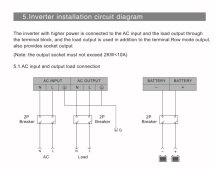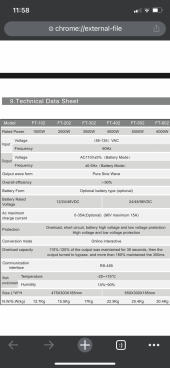My inverter manual sucks. I can’t find the answer anywhere on Google, but I’m betting y’all will know.
I just got my 12v/3000w inverter. I’m looking through the manual and it says (I think) that the AC input, AC output, and the battery connections all need two pole breakers. I haven’t done much with circuit breakers, but I’ve only seen double breakers on 240v appliances like stoves and dryers. And don’t two pole breakers have two positive wires? Why would I need 2p breakers on all (or any) of those? There’s only terminals for a positive, negative, and ground.
Also, I’m only running one circuit off of this. Three 20A outlets that will never run at the same time. I doubt if I’ll ever really run more than two things at once.
I’m hella confused and I’ve attached the entire section from the manual for wiring up the AC.
I don’t think the other specifics of my system will matter too much for this, but I can give more info if needed.
I just got my 12v/3000w inverter. I’m looking through the manual and it says (I think) that the AC input, AC output, and the battery connections all need two pole breakers. I haven’t done much with circuit breakers, but I’ve only seen double breakers on 240v appliances like stoves and dryers. And don’t two pole breakers have two positive wires? Why would I need 2p breakers on all (or any) of those? There’s only terminals for a positive, negative, and ground.
Also, I’m only running one circuit off of this. Three 20A outlets that will never run at the same time. I doubt if I’ll ever really run more than two things at once.
I’m hella confused and I’ve attached the entire section from the manual for wiring up the AC.
I don’t think the other specifics of my system will matter too much for this, but I can give more info if needed.




